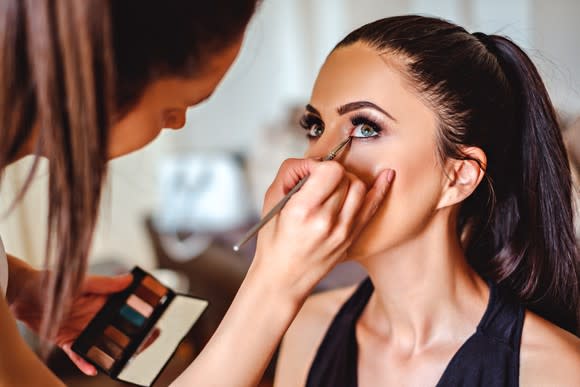Amazon.com Is Looking Pretty When It Comes to Cosmetics Sales
Because of its size, Wal-Mart (NYSE: WMT) is the behemoth of the beauty care industry. A Prosper Insights & Analytics survey showed more people shopped the retail giant for cosmetics than any other store by around a 3-to-1 margin. Since price was the reason most often cited by consumers, followed by selection, it's not surprising that Wal-Mart dominated the category.
Yet it is those exact same reasons that give Amazon.com (NASDAQ: AMZN) a chance to upset the beauty and personal care industry, a development that could spell trouble for cosmetics retailers like Sephora and Ulta Beauty (NASDAQ: ULTA).

Image source: Getty Images.
The looming shadow
E-commerce represents around 8% of the total beauty and personal care market, according to a report from Fung Global Retail & Technology (FGRT), and through the combined heft of its third-party retailers, along with its own sales, Amazon is the leading e-tailer with a 35.5% share of the online market in 2016, or twice as much as second-place Macy's. Sephora came in third with a 15% share and Ulta, with 8.2%, was fourth.
Yet Amazon experienced tremendous growth in 2017, with information from One Click Retail and Clavis Insight estimating the e-commerce leader saw 47% growth in luxury beauty sales, which generated $400 million in revenues. The category of "mass cosmetics" reportedly jumped 60% for Amazon in the second quarter of 2017, making it the fastest-growing category. Cosmetic brands are generally separated into luxury/prestige and mass.
Although the benefit of shopping at Ulta and Sephora has been the combination of selection and in-store experience, e-commerce is taking on critical importance.
An ultimatum for change
Ulta remains in expansion mode, opening more than 100 stores over the first three quarters of 2017. While same-store sales are still in double-digit territory, the company is in danger of seeing them slip below that threshold. Where comps had been north of 14% in the first quarter of last year, they'd fallen to just above 10% in the third.
Online sales, though, were up 63% in the third quarter and are nearly 70% higher across the first nine months of the year. Ulta also says it's going to be adding more mass cosmetics to its collection this year, as it undergoes a big reset, which it views as an important avenue for bringing in new customers.
Prestige brands like Clinique, Lancome, and MAC are among Ulta's biggest sellers, and it said they accounted for about one-third of comps growth for the third quarter, but it sees mass brands like e.l.f. Beauty (NYSE: ELF), which sells many items under $5, as part of its future, and it will be rolling that company's products out across its stores this year, as well as other mass brands.
Additional selection may attract more customers, but it's also going to position Ulta Beauty against mass cosmetics industry stalwarts like CVS and Walgreens, which are estimated to together account for between 11% and 16% of industry sales, depending upon age group. It will now put it in direct competition with Amazon, too.
Virtual beauty
Virtual reality is going to play a bigger role in how cosmetics are purchased. Sephora, for example, has an called Cheek Try On that allows customers to use augmented reality to see how makeup would look before buying. Rival MAC also has its own augmented reality mirror, and brands such as CoverGirl, Estee Lauder, L'Oreal, and Maybelline all have virtual try-on apps as well.
Amazon doesn't have a cosmetics virtual reality app just yet, but much has been made of its augmented reality capabilities for apparel, allowing consumers to see how clothes would look on them before buying. It doesn't seem like it would take much for the company to use that same technology with cosmetics -- or to buy a company like ModiFace, which provides the VR technology to those beauty companies above -- to make the gap disappear between it and its brick-and-mortar competition.
Amazon.com is clearly making a full frontal attack on the beauty and personal care industry, and though its sales might still be small in relation to Ulta, Sephora, or even Wal-Mart, with the growth it is experiencing in mass cosmetics and prestige sales, it may quickly overtake them one day.
More From The Motley Fool
John Mackey, CEO of Whole Foods Market, an Amazon subsidiary, is a member of The Motley Fool's board of directors. Rich Duprey has no position in any of the stocks mentioned. The Motley Fool owns shares of and recommends Amazon. The Motley Fool recommends CVS Health, e.l.f. Beauty, Inc., and Ulta Beauty. The Motley Fool has a disclosure policy.

 Yahoo Finance
Yahoo Finance 